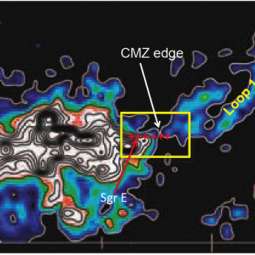SOFIA measurements of ionized carbon and nitrogen gas at the edge of the Central Molecular Zone (CMZ) of the Milky Way were made with the GREAT far-IR heterodyne spectrometer (P.I. Rolf Güsten, MPIfR) as a part of SOFIA’s Guest Investigator program. The observations were made over the course of several nights in July 2013 during SOFIA’s first Southern Hemisphere deployment.
The CMZ is a 400 pc x 80 pc region around the galactic center containing 10 million solar masses of giant molecular clouds, many regions of active star formation, and frequent supernova explosions.
GREAT (German REceiver for Astronomy at Terahertz frequencies) observed the singly-ionized carbon [C II] spectral line at a wavelength of 157.7 microns and singly-ionized nitrogen [N II] at 205.2 microns towards six locations in the CMZ shown in Figure 1.
Some of the GREAT spectra are shown in Figure 2. Detection of [C II] and [N II] emission indicates the presence of warm, dense ionized gas at the edge of the Central Molecular Zone. These new observations show that the ionized gas in the CMZ extends 7-14 pc further out in galactic radius than does the molecular gas, requiring a source of exceptionally intense EUV radiation. It is an open question whether the number of hot, luminous young stars in this region is sufficient to produce the EUV flux, or if additional sources of EUV and X-ray radiation must be present.
Further information can be found in the paper by W. D. Langer, P. F., Goldsmith, J. D. Pineda, T. Velusamy, M. A., Requena-Torres, and H. Wiesemeyer, 2015 , Astronomy & Astrophysics, 576, A1.

